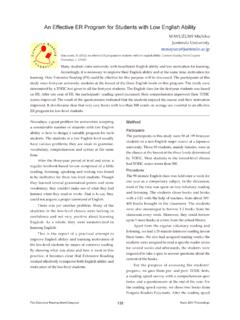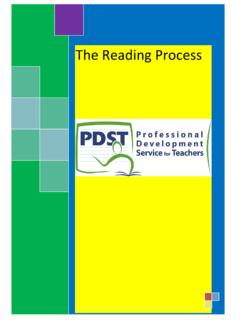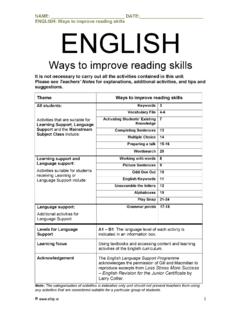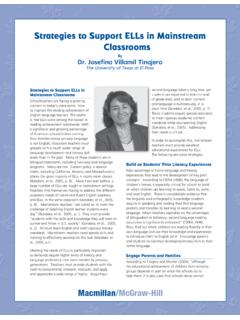Transcription of 2 Key Issues in L2 Reading Development - NUS
1 2 Abstract: Key Issues in L2 Reading DevelopmentWilliam GrabeNorthern Arizona The The nature of fluent Reading and the way that Reading comprehension is carried out The Reading construct as the goal for the Development of Reading abilities. 4. Expertise and Reading : Get a good Implications from research for Reading Curricular and instructional options for effective L2 Reading instruction settings. The ability to read fluently is, in fact, quite miraculous. Our brains were not designed to be Reading brains. But we have learned, from one generation to the next, to take graphic forms on a page and mentally interpret them into our own language, no matter what language. As fluent readers, we do this at a rate that is even faster than our fluent listening abilities. What is more remarkable, we can do this for hours at a time if we choose to, and we often do this for enjoyment!
2 So what is it we do when we read, and how do we do it? I will address this large question, but do so in the context of academic Reading because that is the key concern for ability to read English efficiently for academic purposes is widely recognized in EFL/ESL contexts as a critical skill in a wide range of secondary and university settings, and especially for more advanced students. I will first review the nature of (English L1) fluent Reading and the way that Reading comprehension is carried out cognitively. This foundation helps define the Reading construct of the fluent reader , here viewed as the integration of many component skills. Determining the construct then provides rationales for the Development of Reading abilities and various instructional practices. The focus of this chapter will not be an extensive review of the Reading construct.
3 That has been developed in more detail in other sources ( , Grabe, 2009; Koda, 2005; Perfetti & Adlof, 2012; Rayner et al., 2012). Instead, the goal is to draw connections from the Reading construct to potentially effective ways to teach Reading . Defining Reading Reading can simply be defined as a complex ability to extract, or build, meaning from a text. However, this definition, by itself, is not very informative. The most commonly accepted way for researchers to explain the above definition is to identify the key component abilities and skills that allow Reading comprehension to emerge. Reading comprehension involves abilities to recognize words rapidly and efficiently, develop and use a very large recognition vocabulary, process sentences in order to build comprehension, engage a range of strategic processes and underlying cognitive skills ( , setting goals, changing goals flexibly, monitoring comprehension), interpret meaning in relation to background knowledge, interpret and evaluate texts in line with reader goals and purposes, and process texts fluently over an extended period of time.
4 These processes and knowledge resources allow the reader to generate text comprehension to the level required. The identification of these skills and resources has been the outcome of many research studies, and it remains the source of much ongoing research. These skills work together in a complex, finely-coordinated set Key Issues in L2 Reading Development 8In this article, I provide an overview of key Issues for L2 Reading Development . The goal is a succinct summary of ideas that should support more effective teaching and improve students Reading abilities. The article first outlines the nature of Reading abilities, particular in academic contexts, and identifies major component skills and knowledge bases needed for L2 Reading comprehension. From this foundation, a set of research implications for instruction are noted. These implications, in turn, form the basis for recommended teaching practices that will build comprehension abilities.
5 Nine specific curricular and instructional themes are then presented briefly and suggestions for teaching and curriculum planning are explored. The article concludes by noting the need for additional research to validate, and to provide new insights into, effective teaching processes (Grabe, 2009; Koda, 2005; Cain & Oakhill, 2012; Perfetti & Adlof, 2012). In this section, research is reviewed that supports the relationship between Reading skills and Reading comprehension. Much of the research has been conducted in English L1 Reading contexts, though increasing amounts of L1 Reading research in other languages has also emerged in the past fifteen years (Joshi & Aaron, 2006; Verhoeven & Perfetti, 2011). Reading Processes: How does Fluent Reading work? In this brief section, I have divided Reading abilities into lower level and higher level processes.
6 All processes occur in working memory which can be understood as the pattern of cognitive neural network activations at any given moment. Lower level processes do not mean that they are easier. In some respects, they are much harder to develop for L2 readers. Lower level processes include fast, automatic word recognition skills, automatic lexico-syntactic processing (automatically recognizing word parts and morphological information and automatically parsing the immediate clause for syntactic information), and semantic processing of the immediate clause into relevant meaning units (or propositions). Higher level processing involves those processes and resources that more closely align with strategies and resources for comprehension with more difficult texts: (a) form main idea meanings, (b) recognize related and thematic information, (c) build a text model of comprehension (an author-driven summary understanding), and (d) use inferencing, background knowledge, strategic processing and context constraints to create a situation model of Reading (a preferred personal interpretation) (Hannon, 2011; Perfetti & Adlof, 2012).
7 Lower level processing: Research on Reading has shown that beginning readers need to establish strong linkages between orthographic forms and the sounds of the language (Ehri, 2006; Cain & Oakhill, 2012; Rayner et al., 2012). Extensive research in L1 contexts across languages has demonstrated that training in phonological awareness and letter-sound correspondences predicts later Reading Development among children and beginning readers (Ehri, 2006). While L1 Reading in other languages may not require that same level of instructional effort as does English for phonological awareness, all young learners benefit from explicit instruction in letter-sound correspondences (Lundberg, 1999). The automatization of letter-sound relations is the foundation of all alphabetic Reading and supports syllabic Reading systems as well.
8 Even Chinese, as a morpho-syllabic system, incorporates information from the phonetic radical within characters to aid word recognition and uses phonological information at the point of lexical access; Chow, McBride-Chang & Burgess, 2005; He, Wang & Anderson, 2005).Research on English L1 vocabulary knowledge has demonstrated that fluent readers have very large and automatic recognition-vocabulary knowledge and that vocabulary knowledge is highly correlated with Reading ability (see Grabe 2009; Grabe & Stoller, 2011). While estimates of English L1 word knowledge vary greatly (from 19,000 to 200,000; Anglin, 1993), the most widely accepted figure is that high school graduates know on average 40,000 words as fluent L1 readers (Stahl & Nagy, 2006). This is a very large number of words to learn and most accounts suggest that many of these words are learned by exposure to new words through continual Reading practice.
9 Stanovich (2000) has argued that extended exposure to print ( Reading extensively) over years leads to major differences in both vocabulary knowledge and comprehension abilities. Research on L2 vocabulary knowledge has also shown that vocabulary is correlated with L2 Reading comprehension. Droop and Verhoeven (2003) reported a strong relationship between 3rd and 4th grade L2 students vocabulary knowledge and their Reading abilities. (See also Qian, 2002).Research on L1 morphological and syntactic knowledge shows that they both have an impact on Reading comprehension. A number of studies have shown that morphological knowledge contributes to Reading comprehension. Research by Anglin (1993), Nagy et al. (2006), and Wagner, Muse & Tannenbaum (2007) all argue that morphological knowledge (knowledge of word parts) is very important to more advanced word recognition and Reading Development (see also Bowers, Kirby & Deacon, 2010; McCutchen & Logan, 2011; Kieffer, Biancarosa & Mancilla-Martinez, 2013).
10 There is also evidence that grammatical knowledge and discourse knowledge both play roles in L1 Reading comprehension (Lesaux, Lipka & Siegal, 2006; Perfetti and Adlof, 2012; Trabasso & Bouchard, 2002). Research on L2 syntax has shown that there are strong relationships between these language knowledge bases (syntax and discourse awareness) and Reading comprehension (see Grabe, 2009; Shiotsu, 2010). For the fluent reader , automatic semantic processing of texts occurs at the same time that automatic syntactic parsing is been carried out (See Perfetti & Adlof, 2012; Rayner et al., 2012). For a brief explanation, Grabe and Stoller (2011) identify the importance of propositional meaning units in the building of text main-idea comprehension. There is strong research evidence to show that fluent readers automatically process the meaning units that they extract from the syntactic parsing of clauses ( , who does what to whom, and how, and when).
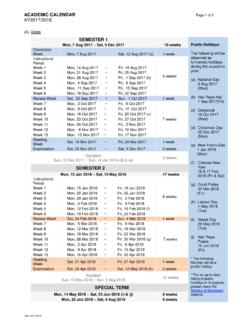
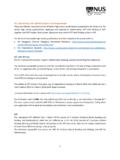
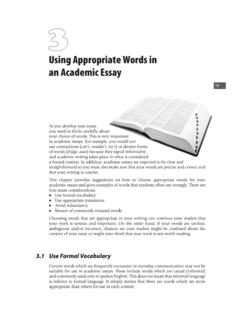
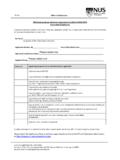
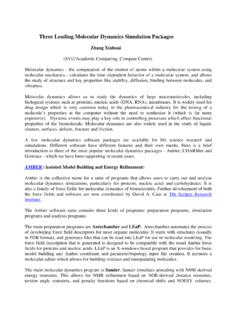
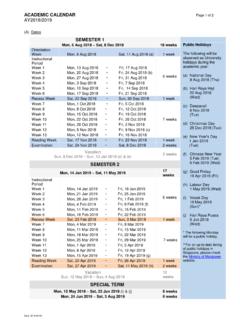
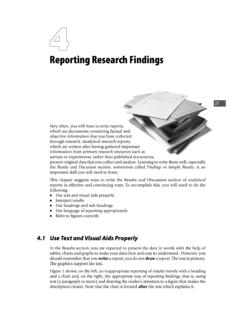
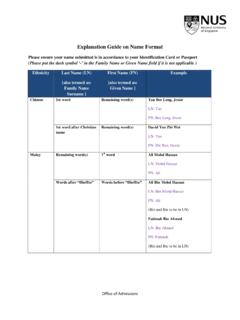
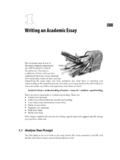
![Guide to Application Form [International Students]](/cache/preview/8/9/a/0/5/0/1/3/thumb-89a050137b2263103e521b3c6af21944.jpg)
